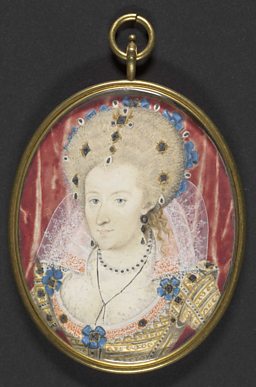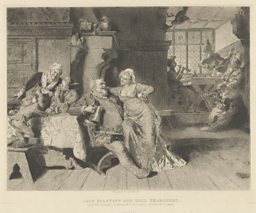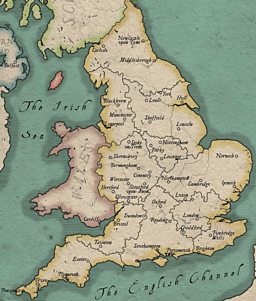Queen Anne uses 'soft power' against the Somerset puritans
Although there are no records of Shakespeare's troupe of actors visiting Somerset during the Bard’s lifetime, there are performances from other acting companies which illustrate the tensions between the Puritans and the traditionalists
These were tensions which Queen Anne found herself right in the middle of… and tensions which are prominent in Shakespeare’s plays.
-
![]()
Much ado near me
Hear more Shakespeare stories on BBC Somerset
-
![]()
Shakespeare Festival 2016
The BBC celebrates the genius of the bard

In 1613 - the same year that Shakespeare retired - Queen Anne, the powerful wife of Shakespeare's patron, King James, went on a journey from Bath to Wells to support the traditionalists there who had come under attack in 1607 by local puritans for staging their traditional shows and plays.
Shakespeare's plays ... present a sustained critique of puritan excesses
She appears to have brought much of her court with her. The Wells Civic Convocation Book describes the extraordinary array of colourful shows that the citizens of Wells staged for her when she arrived.
The court used its several troupes of players, and the royal family itself, to counter puritan efforts to control the governance of towns and to suppress traditional culture.
As the King's playwright, Shakespeare's plays, for example, present a sustained critique of puritan excesses - as seen for example in Henry IV, Pt 1, and Measure for Measure.
The attempted takeover of culture had happened in Wells in 1607, countered by the locals with a truly astounding array of mocking shows.
Queen's players perform in Bridgwater to stem the puritan tide
Queen Anne's own players visited Bridgwater in 1606-7, seemingly coming from Bath, since they performed there in both 1605-6 and 1606-7.
Shakespeare's unique and brilliant sympathy for women in his plays cannot have been lost on the Queen's own players
Bridgwater had its own troubles with protests and tensions as puritans tried to impose greater control.
When court sessions were held there, records are filled with attempts to suppress bear baiting, May games, and any number of other traditional customs and pastimes.
The visit by the queen's players does seem intended to show the flag, as it were, and calm down the punishing judges.
Says REED editor James Stokes: “The world of royal-sponsored players was a very compact and privileged one. I can't imagine that Queen Anne's players and those in Shakespeare's troupe would not have known each other. They all were also singing from the same ideological and political hymnal, so to speak, in choosing their plays. I could not say for certain that they performed some of Shakespeare's plays, but they certainly would have been influenced by them. Shakespeare's unique and brilliant sympathy for women in his plays cannot have been lost on the Queen's own players.”
A real life Shakespearean ale house scene in Somerset
In 1607/8, a number of locals from the village of Croscombe faced the courts for an incident near Christmas time in the local alehouse.
It appears that the card-players in the ale house awakened one Richard Jellycombe, who was then drunk and asleep by the fire.
An entire spontaneous scene ensues…the episode in Croscombe almost perfectly mirrors the tavern scene in Henry IV, Pt 1, in which Falstaff and Hal do much the same.
The incident shows no direct influence of Shakespeare, of course, but it does show the common response to the puritan reform movement, just as Shakespeare's scene shows his obvious familiarity with the alehouse world.

The Puritanical backlash against theatre
One of the most peppery of the Puritans in Elizabethan times is the pamphleteer Philip Stubbes.
Stubbes is perhaps best known for his popular book The Anatomie of Abuses (1583) in which he claims to expose some of the supposed ‘abuses’ in Elizabethan society and the theatre comes in for particular stick.
In Shakespeare and other dramas of the day it is the men who also play female parts. Stubbes and his supporters, known as anti-theatricalists, refer to men who dress up as women as “monsters of both kinds, half women, half men”. They consider such cross-dressing as a depravity.
Carrie Blais, commentating on the life of Philip Stubbes, writes: “Although stage cross-dressing was a necessity brought about by the all-male Elizabethan stage (women in England were barred from performing on the public stage until after 1660), critics have noted that Shakespeare’s use of cross-dressing is complex, and in fact may question the patriarchal structures of his time.
“Shakespeare attempts to undo the policing of gender boundaries and this attempt may perhaps be partly why the anti-theatricalists were so anxious about 'real' gender boundaries.”
Stubbes also argued that plays were magic. They had the power to turn men into aggressive beasts on stage – and that audiences might be drawn into the magic by imitating what they see.
Dismissing them as "filthy plays and bawdy interludes" Stubbes goes so far as to accuse them of being the work of the devil.
His work was a big success – it had four editions – clearly striking a chord with like-minded Puritans who also believed, like Stubbes, that "leisure leads to vice".
Shakespeare on Tour
From the moment they were written through to the present day, Shakespeare’s plays have continued to enthral and inspire audiences. They’ve been performed in venues big and small – including inns, private houses and emerging provincial theatres.

BBC English Regions is building a digital picture which tracks some of the many iconic moments across the country as we follow the ‘explosion’ in the performance of The Bard’s plays, from his own lifetime to recent times.
Drawing on fascinating new research from Records of Early English Drama (REED), plus the British Library's extensive collection of playbills, as well as expertise from De Montfort University and the Arts and Humanities Research Council, Shakespeare on Tour is a unique timeline of iconic moments of those performances, starting with his own troupe of actors, to highlights from more recent times. Listen out for stories on Shakespeare’s legacy on your BBC Local Radio station from Monday 21 March, 2016.
You never know - you might find evidence of Shakespeare’s footsteps close to home…
Craig Henderson, BBC English Regions
Pressure from the Puritans
Driven by their literalist reading of Scripture, the puritans opposed any traditional festive activities (Robin Hood games, May games, etc), especially if they occurred on a Sunday or holy day, accusing them of being pagan and papist, therefore blasphemous.

They ranged from the outrageously funny- the man who was in court for having had carnal knowledge of a woman against the maypole, thereby causing the bell atop the pole to ring...
They mainly used the church courts, the county courts, and local constables to prohibit and ultimately destroy the entire tradition of pious parish forms, used for fund-raising and fun. But Somerset was a highly conservative county that fiercely resisted the puritan reformists, which led to resistance and pitched battles (legal, judicial, social, sometimes literal) when locals insisted on mounting their entertainments in the face of authority.
Somerset is a compendium of those real world encounters. They ranged from the outrageously funny (the man who was in court for having had carnal knowledge of a woman against the maypole, thereby causing the bell atop the pole to ring) to the very dark (the parading and flogging of a young couple in Glastonbury, with fiddlers playing before them, because they had conceived a child on a Sunday while coming from dancing).
The shows of 1613, and the protests that occurred throughout Somerset, have their brightly reflecting mirror in the plays of Shakespeare.
By James Stokes, Suffolk editor from the Records of Early English Drama
Shakespeare on Tour: Around Somerset
-
![]()
The Masons host Hamlet
Taunton attempts to establish a theatre
Related Links
-
![]()
Shakespeare Lives
The nation’s greatest performing arts institutions mark 400 years since the Bard's death

Shakespeare on Tour: Around the country
-
![]()
Ira Aldridge
Ira Aldridge - the first black Shakespearean actor
-
![]()
Blossoming at the Rose Theatre
Shakespeare, budding playwright and actor, at the Rose Theatre from the spring of 1592
-
![]()
Will Kemp dance finished in Norwich
Why did Will Kemp, Shakespeare's former clown, dance from London to Norwich?
-
![]()
London's Female Romeo
Charlotte Cushman, the American actress who took Victorian London by storm








